-
 Funerary Stele of Atrastas, son of Timles
Funerary Stele of Atrastas, son of TimlesR2 Cat. 234
Sculpture
Marble, Stone
330-329 BC (Hellenistic)
C. H. Greenewalt, Jr. noted that at the top, the relief molding has painted egg and dart motif, yellow with black background. There are five lines of text in Lydian, with red preserved in some letters. Below the text is a sculptured scene showing a m...
-
 Relief with Funerary Meal
Relief with Funerary MealR2 Cat. 234bis
Sculpture
Marble, Stone
300 BC (Hellenistic)
The bearded man lies on a couch with a drinking cup in his I. hand. A snake coils over his l. shoulder and his veiled wife sits at his feet. Before him stands a three-legged table, beside it a wine jar and a small boy who is serving the wine. On the ...
-
Lion Sejant From Nannas Monument
R2 Cat. 235
Sculpture
Marble, Stone
Ca. 500 BC (Late Lydian (Persian))
The lion is seated in a frontal position. The tail loops under the hindquarters and over the left haunch. The mane has long wavy locks ending slightly down the back, less deeply cut than Synagogue lions (Cat. 25A, Cat. 25B Figs. 92-101). The style is...
-
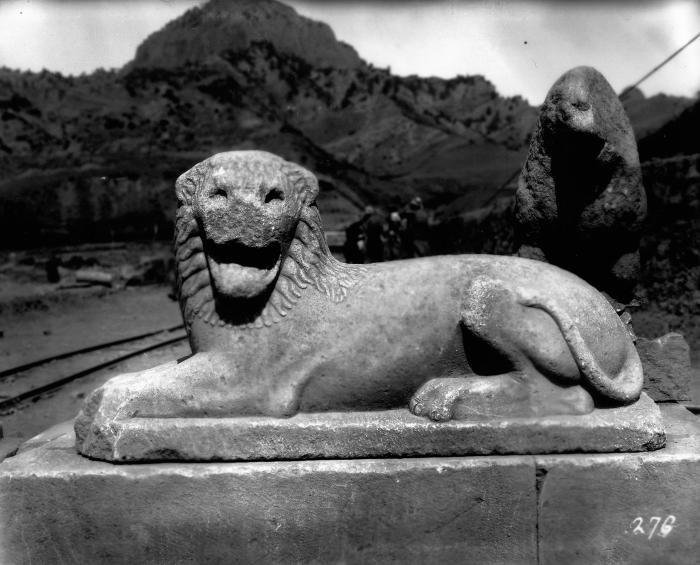 Recumbent Lion From Nannas Monument
Recumbent Lion From Nannas MonumentR2 Cat. 236
Sculpture
Marble, Stone
550-540 BC (Lydian or Late Lydian)
On a plinth with forepaws extended in front, the lion has its head turned to the l. with the mouth wide open and tongue protruding. The eyes are hollow for inlay, the ears fairly close to the head. The mane is arranged in leaf-like locks, many ending...
-
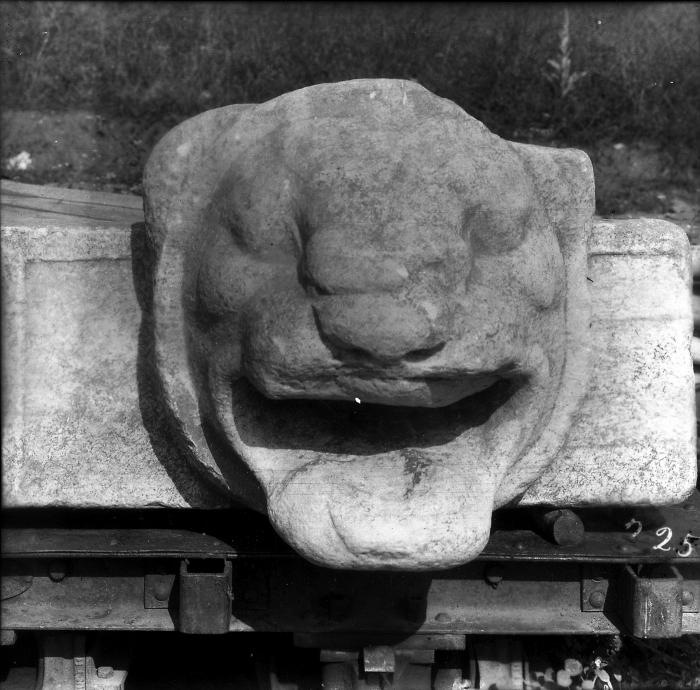 Lion Spout Attached to Rectangular Member
Lion Spout Attached to Rectangular MemberR2 Cat. 237
Sculpture
Marble, Stone
(Lydian?)
"This [colossal lion's head] in all probability belonged to the cornice of the temple and when in place, stood in a position almost directly above the spot where it was found, being the water-spout nearest the corner of the temple. The scale of the h...
-
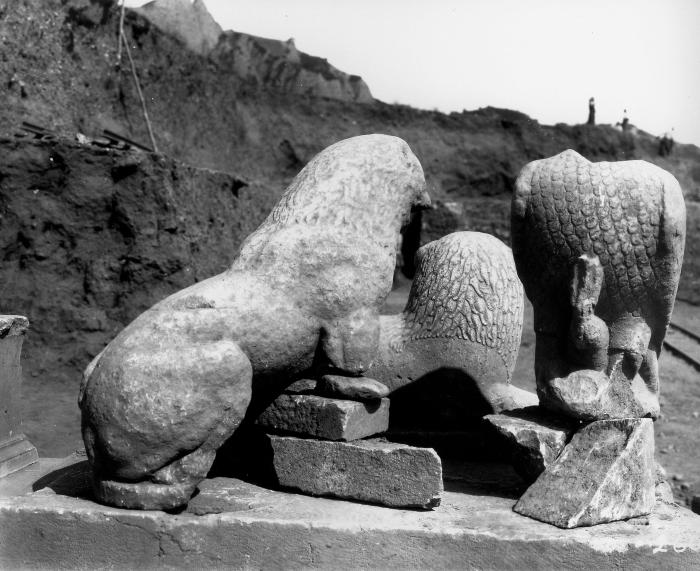 Bird of Prey (Eagle?) Holding a Hare, from the Nannas monument
Bird of Prey (Eagle?) Holding a Hare, from the Nannas monumentR2 Cat. 238
Sculpture
Marble, Stone
Late archaic? (Lydian?)
A sitting bird of prey is holding with slightly bent talons a long-eared creature -- hare or rabbit. The wings are folded on the back; they have three tiers of long feathers, while the front part is stylized in small vertical ovals. The chest feather...
-
 Sphinx, presumably part of a throne or seat
Sphinx, presumably part of a throne or seatR2 Cat. 239
Sculpture
Marble, Stone
480-450 BC (Late Lydian (Persian))
The seated sphinx is partly in the round, partly in relief. A rectangular slab has been worked so that the forelegs and frontal lower part of the body stand free. Behind the head (now lost) and upper part of the body the background was retained and w...
-
 Part of Sepulchral Stele with Palmette
Part of Sepulchral Stele with PalmetteR2 Cat. 240
Sculpture
Marble, Stone
Ca. 420-400 BC (Late Lydian (Persian))
The stele has an oval finial, seven-petalled palmette on antithetic horizontal spirals, and downward-pointed small lotus. The anthemion projects slightly to the spectator's r. "The lateral projection ... was probably next to the dromos, whereas the s...
-
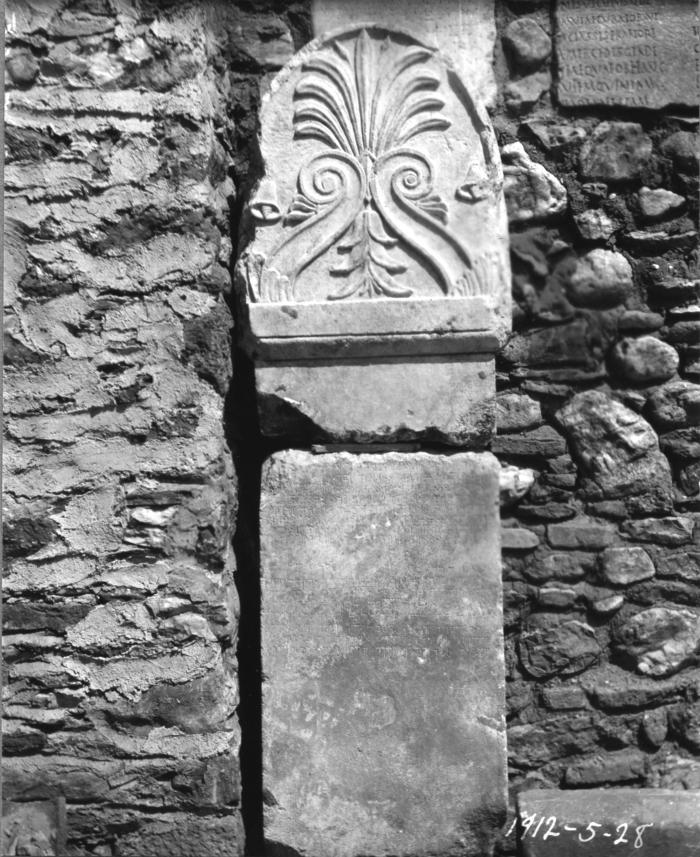 Anthemion with Lydian-Aramaic Bilingual Inscription, Stele of Manes, Son of Kumlis
Anthemion with Lydian-Aramaic Bilingual Inscription, Stele of Manes, Son of KumlisR2 Cat. 241
Sculpture
Marble, Stone
394 BC (Late Lydian (Persian))
Two vertical half-volutes grow out of small acanthus chalices to support a seven-leaf simple palmette. Two small flowers (or ears of corn?) flank the central petal. Three large downward-pointed chalices are in the center below the palmette. Below the...
-
 Stele of Alikres, Son of Karos
Stele of Alikres, Son of KarosR2 Cat. 242
Sculpture
Marble, Stone
Early 4th C. BC (Late Lydian (Persian))
Funerary stele with Lydian inscription and rounded palmette anthemion, stele of Alikres, son of Karos.
Grayish "local" marble. Much reddish incrustation on face. Piece of marble broken off at top. According to Buckler (Sardis VI, 2, 49) bottom is origi...
-
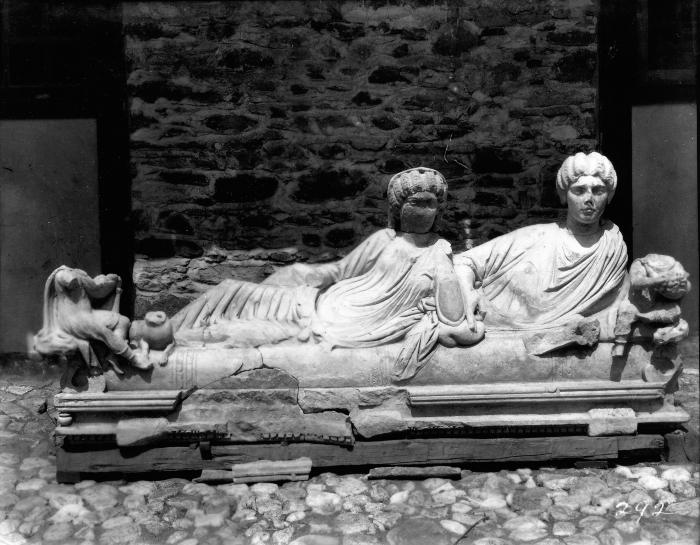 Sarcophagus of Claudia Antonia Sabina
Sarcophagus of Claudia Antonia SabinaR2 Cat. 243
Sculpture, Sarcophagus
Marble, Stone
2nd or early 3rd C. AD (Roman)
For full description and discussion, see Sardis V, 3ff.; Mansel, Erwerbungsbericht, 176, fig. 6; Ferrari, Commercio Sarcofagi, 39; Lawrence, Additional Sarcophagi, 116ff.; Wiegartz, Säulensarkophage, 158 (Istanbul G) and further bibliography therein....
-
 Sarcophagus Fragment
Sarcophagus FragmentR2 Cat. 244
Sculpture, Sarcophagus
Marble, Stone
Ca. 170-180 AD (Roman)
The corner fragment comprises "the cornice of the left intercolumniation of a lateral face, and the left extremity of the adjacent raking cornice" (Sardis V, 39). The interior border is raised to hold the lid. The acroteria consist of a headless anim...